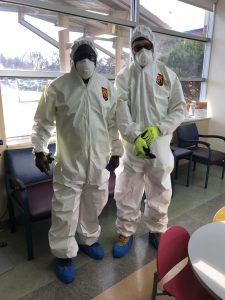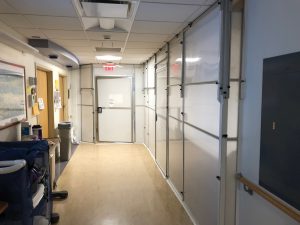First Responders: Healthcare Construction in a Pandemic
COVID-19 upended the way we all live and work. But nothing compares to the impact it has had on the healthcare sector. Not only were healthcare workers on the front lines sacrificing their health to battle the virus, but healthcare facilities and processes had to be entirely reconfigured to care for patients and protect against further infection.

As it became clear the virus was spreading worldwide, hospitals began proactively thinking about what they could do to get ahead of the predicted surge. For some healthcare clients, that meant reevaluating how they were using their spaces—including those under construction.
In New York City, LF Driscoll Healthcare is working on several renovation projects, including a 15-bed surgery unit. The hospital asked the project team to work together to convert some of the in-process patient rooms into negative air pressure rooms.
“The project was well underway, and we were asked to modify it on the fly,” says Christopher Shaw, vice president at LF Driscoll Healthcare. “We reworked the design collaboratively, making decisions based on what materials were readily available and really focusing on how we could get the job done before the next potential surge, but still safely within our site COVID-19 guidelines.”
In New Jersey, Structure Tone’s healthcare clients were going through a similar exercise, assessing what was coming and how they could prepare. Finding essential materials and equipment quickly became the focus.
Structure Tone responded, connecting them to suppliers for those materials and donating their in-house stock of negative air machines, as well as dust barrier systems, door window kits, coverall suits, and hundreds of N95 masks. At the same time, the team mobilized to act on dozens of projects to retrofit the hospitals’ existing spaces for infection control, from replacing interior windows with insulated metal panels to in-stalling Edge Guard barriers to create isolation rooms and temporary treatment areas.
“We’re used to working at a fast pace in healthcare,” says Joseph MacInnes, healthcare sector leader for Structure Tone New Jersey. “We were calling all of our vendors and new vendors and working with our subs to explore all options. Everyone really came together.”
That kind of teamwork came in especially handy for LF Driscoll when Penn Medicine asked the PennFIRST project team to fast-track part of the construction of the 1.5Msf new hospital Pavilion in the event additional space would be needed during the COVID-19 pandemic.

PennFIRST is the integrated project delivery (IPD) team designing and building the massive project, which is scheduled to open in 2021. The goal of their IPD approach is to stay ahead of the curve, developing innovative solutions and working in partnership with each other and the building trades to keep the project moving forward.
The design was intentionally divided into area teams to allow planning, design, and construction to advance in separate but distinct tracks. As the structural steel, concrete, and façade phases wrapped up, the team moved on to the core-and-shell mechanical system and began fit-out throughout the building. However, in the midst of that progress, COVID-19 took hold.
Penn Medicine assessed its facilities and determined that temporarily shifting the focus of the Pavilion construction to where the fit-out was progressing could provide additional space for treating patients, if needed, during this time. With the project’s scheduled completion still more than a year away, the PennFIRST team refocused on rapid response.
“The IPD process put us in an excellent position to respond quickly to this emergency response,” says Ed Hanzel, senior project executive with LF Driscoll. “With all stakeholders working directly together already, we could quickly adjust to changes and help Penn Medicine serve its community in this unprecedented time of need. In three weeks, we were able to make 120 patient rooms available if they needed them.”
While working in healthcare is rewarding on its own, helping the front lines fight the pandemic brought the STO teams an added level of pride. “We knew what we had to do,” says Shaw. “We had a mission to help our clients help their patients, and we’ve been laser-focused on having each other’s backs to get it done.”
